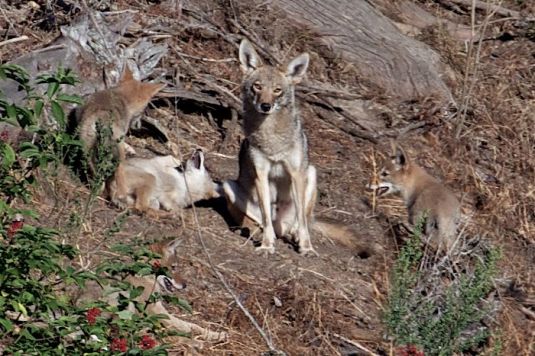Coyote pupping season is here: mid-April is when pups will start being born. Expectant mothers may go into a time of “confinement” for the birthing period. In previous years I have seen the new mothers much less often and sometimes not at all for an extended period. Food may be brought to them by the male or other family members. A female coyote’s becoming less conspicuous is often the first sign that a new family is being raised. The more definite sign will be if someone spots her as a lactating mom: her tits will be engorged.
Female coyotes have litters only once a year. They mate only in February during a short 10 day period. Males, too, only produce sperm during this period, I have read. The gestation time is nine weeks, and a normal litter size is from 4-7. It seems that the territory size and the amount of resources on it might affect litter size. In an urban park with limited resources, the litters appear to be smaller in size. Respecting wildlife means allowing them to raise their families with a feeling of safety: this means not seeking out their dens. So, although we can’t be sure how many pups are originally born to any particular female — this is because survival rates are sometimes as low as 5-20% — if we are lucky, we can often count the pups who do live to become adults. In one instance we know that two years ago one of the females in one of the local parks ended up with just ONE pup, and last year, this same female ended up with TWO pups. This year NONE were born at all. Is this population control? Or is it a sign of a stressful environment with too many dog incidents in the parks?
The pups normally leave the den at around 4 to 5 weeks of age, and actually stop using the den after they double this age. I have seen that the families are strong, staying together for at least a year, which allows time for the pups to learn all they can, and allows parents to help with feeding and protection. I have seen some pups disperse — leave the family and the area — at about a year-and-a-half of age, but others stay on to remain with the family that raised them. It is only a dominant female and leader of the group who is allowed to reproduce in any one “pack”. IF a younger female ends up having pups, she is kicked out of the pack — or so I have heard. I have not seen an instance of this. How long do feeding and suckling actually continue seems to vary. I have seen a mother carry off a gopher towards her “home” or den area as late as December. There is the possibility that this female was carrying off the gopher to bury it somewhere. However, because she hurried off towards her “home” area, I am assuming it was to give to a youngster, as I had seen her do many months before.
And, although the right-hand photo may show a submissive approach to the mother, as I have seen often, it appears actually that this youngster may be attempting to suckle as late as December — that pup was eight months old and full-sized. This particular youngster is particularly shy of humans — is usually the quickest to flee and hide — but will only occasionally allow himself to be seen with his family group, as long as he can look up to them for guidance — this is at close to one year of age. This particular coyote also seems to love to play — he’s ready to do so often: tossing up what serves as a ball or toying with a floppy item which I could not identify, or enticing the other coyotes to play chase. The other coyotes in this group appear to keep an eye out for this one and oblige him with the playing.
Specifically in one coyote family group, I have not seen a father around on a regular basis. I spotted the male fleetingly only twice with the female, once in her park and once far from her park — but this was last year. The males I have come across are much shyer than the females and seem to prefer not being seen at all.
Please be considerate of the coyotes during this time, by giving them extra space and calmness when you visit the parks with your dogs. Please leash your dogs for your dog’s AND for the coyote’s feeling of safety and protection. If you see a coyote, keep walking on.










